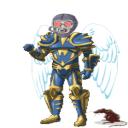Yahoo Answers is shutting down on May 4th, 2021 (Eastern Time) and beginning April 20th, 2021 (Eastern Time) the Yahoo Answers website will be in read-only mode. There will be no changes to other Yahoo properties or services, or your Yahoo account. You can find more information about the Yahoo Answers shutdown and how to download your data on this help page.
Trending News
Is there a way to write compelling robot characters?
Humanly relatable and engrossing but feel realistically artificial?
10 Answers
- VerityLv 71 month ago
Please, read Isaac Asimov's "Elijah Bailey" stories ("The Caves of Steel", "The Robots of Dawn", etc.). Elijah Bailey is a detective in the near-future whose partner,
R. Daneel Ovillaw, looks like a human being, but is actually a robot.
- FunnelLv 51 month ago
Makes me want to watch I Robot and Bicentennial Man for the hundredth time on HBO. Then I'll watch again for the hundredth time the other handful of movies I pay extra for on HBO. Yaay.
- 1 month ago
“You cannot dream yourself into a character; you must hammer and forge yourself one.” -James A. Froude
My favorite movie characters are the ones I see a bit of myself in; Holly Golightly, Annie Hall, Sarah Connor. Okay, let me rephrase that. My favorite movie characters are the ones I can emotionally connect with either because I’m sympathetic to their circumstances or the persona they represent on-screen. But what about characters you could care less about? If you’re like me, you lose interest and wonder if it’s not too late to sneak into another theater to find a movie that will hold your attention.It’s critical your screenplay has characters your audience can connect with. A flashy wardrobe and fancy camera work will not make up for bland characters. Compelling characters are developed through their unique life experience and the trials and tribulations they endure.The three biggest pitfalls most beginning screenwriters make are…• characters who have the personality of cardboard cut-outs. Boring!• characters who meander through a story with no real direction• characters that don’t undergo any transformationHere are some tips on how you can add layers to the people taking up residence on the pages of your screenplay.Ask yourself, “Who Are These People?”First, let’s establish the primary characters in your story. Your protagonist (the hero/heroine) will be the driving force behind your story. They will be the ones guiding us through the various stages of the script from beginning to end. Your audience needs to connect with this character in order to stick with them during their journey.On the opposite end of the spectrum is your antagonist, aka the villain. They will be the thorn in your hero’s side, doing everything they can to prevent your protagonist from reaching their goal. Focus on these two characters first and foremost. The rest of your supporting cast will fall into place.Christopher Vogler does a nice job outlining story archetypes in his book, The Writer’s Journey, based on the writings of mythologist Joseph Campbell, The Hero with a Thousand Faces. His characters include;• The Hero – the driving force• Mentor – provides Hero with skills and advice• Threshold Guardian – gatekeepers the Hero needs to get by in order to overcome an obstacle• Herald – a messenger who will give the Hero the information they need to go forth• Shapeshifter – a character who isn’t what they appear• Shadow – the antagonist/villain• Trickster – comic reliefThese characters appear at specific points in the story to guide the Hero during his journey.John Truby approaches archetypes based on the various stages a character goes through during a story. They include the Orphan (either literal or figurative) in Act 1, the Wanderer (seeking information and learning new things) in the first half of Act 2, the Warrior (using all his tools and knowledge to fight for their goal) in the last half of Act 2, and the Martyr (sacrificing something important to themselves for the greater good) in Act 3.Make Your Characters Three DimensionalYou’re going to be spending a lot of time with your characters as you write your screenplay. I suggest you take the time to really get to know them. The better relationship you have with your characters, the easier it is to understand how they are going to act and react to the circumstances in your story. The best way to do this is by writing a thorough character bio.Really take the time to investigate their childhood, family life, work, relationships- I could go on forever. Did they witness anything in their childhood that’s shaped who they are today? What are they passionate about? What’s the best thing that’s happened in their life? Do they have any fears? Any secrets they’re keeping?I highly recommend you take the same detailed approach to your antagonist as well. You might discover that the character you thought was absolutely corrupt or evil has their good points, too. What was it that made them a bad guy? Maybe a childhood event or a loving relationship that turned cold? Keep in mind, for as much opposition your antagonist causes your hero, they’re convinced they’re doing the right thing and your hero is the one complicating matters. These two characters are going to fight vehemently for what they believe is right.Think about it- Darth Vader and the Emperor didn’t want to take over the universe just to annoy the rebels- they believed in their hearts (yes, I just said that) that they were doing the right thing. Granted, they had selfish motives. Everyone’s entitled to their own belief system, right? Don’t we become a little more sympathetic to Vader’s cause when we learn his backstory?Give Your Characters Purpose!Being interesting isn’t enough- your characters need a purpose. Give them goals to work towards. As you identify the things they want you can also identify their obstacles. What’s at stake and why is it so important to your character? How will their world come crashing down if they don’t reach their goal?Think of your character’s goals in terms of their super-objective (the main goal pushing them through the story) and the smaller objectives they have to overcome to succeed at achieving their main goal.Let’s say your story is about a man trying to save his farm from foreclosure. What are the smaller goals he needs to accomplish in order to make saving the farm a reality? He might need to convince the people at the bank he can come up with the money but just needs a little more time. Okay, he buys some time- now what? Still focused on the main goal, he needs to convince his family to support him. How does he get his family’s support? Maybe his wife and kids hate farm life and need a lot of convincing to stay. How does he get them on board?Just because your character has a goal doesn’t mean they’re going to get what they want. Let’s say the bank tells our farmer “no way” and he can’t get the support of his family. Now, what does he do? Every scene, whether it’s your hero getting what they want or a character or event working against him, there needs to be a clear objective.Believe that Change is GoodHow does your character change by the end of your story? Whether it’s for better or for worse, your character needs to be transformed. Rocky changed. Even Dumbo changed. At the end of your story, what lesson has your character learned? Dorothy summed it up best, “there’s no place like home,” after longing for an exciting life away from the farm. These changes aren’t random acts- they need to be based on who they are as characters and the events they experienced throughout the story.Transformation of character isn’t always an outwardly obvious action. Your character may not achieve the physical goal they’re pursuing but might undergo a radical shift in perspective. In some cases, a protagonist won’t change but will affect the characters surrounding themselves in such a way that the other characters undergo a transformation.Obits & Field TripsHaving trouble coming up with your character’s history? The obituaries have some of the richest character descriptions I’ve ever read. If you can’t find inspiration there, you’re not looking hard enough. If that’s too morbid, plan a field trip to a location (whether it be a town, a store, or even a gathering or special event) that your main character would frequent. For the Western I’ve been working on, I pull a lot of ideas from trips to Eastern Oregon, still considered cowboy country to many. Try to get in the head of your character and experience their world.The time you invest in developing your characters on the page will not only create a richer story but will also help your cast and director in the long run. Talented actors and actresses long for roles that portray interesting and challenging characters. For those of you who direct your own work, you know the difference between working with talent that’s done their homework and those who’ve shown up to set and asked, “What do you want me to do?” or, “How do you want me to play this character?”Take the extra time to develop your characters and your audience won’t be the only one thanking you.
 Source(s): https://www.zacuto.com/
Source(s): https://www.zacuto.com/ - bluebellbkkLv 71 month ago
I'm sure there is. But it's every writer's challenge to work out how to write his own characters.
- How do you think about the answers? You can sign in to vote the answer.
- Anonymous1 month ago
Sure. I was going to suggest the Murderbot series, but it looks like someone beat me to it.
- Sir CausticLv 71 month ago
Oh, no. No, there isn't. It's a well known fact that of all the characters a writer can write about, it's robots that are the worst. No-one's ever managed it, ever. Yes, it's probably best to leave off with the robots. They're rubbish and, besides, they'll never catch on in literature, or movies.
- MsBittnerLv 71 month ago
I'd start with seeing how other authors did it well. Martha Wells' "Murderbot" series is excellent.
- ?Lv 71 month ago
The trick is to find an interesting combination of human characteristics and machine/computer type characteristics for your robot. A robot that just does what it has been programmed to do is normally not that interesting. But a robot that has not been programmed quite right and is capable to doing something unintended that normally only a human would do is fascinating. Here are some possibilities:
1) A robot that wants to eat human food and, consequently, is about to explode because there is no way for it to eliminate anything.
2) A robot that wants to have sex with. . . your choice!
3) A robot that gets tired and wants to sleep regardless of what its energy source suggests it is capable of doing at the time.
4) A robot that wants to run for president.
All you have to do is imagine what a human would be like in that circumstance and write that in to a "typical" robot personality. You might go for a mix of 90% normal robot behavior and 10% human behavior. It is easy to write either drama or comedy, depending upon what the human behavior is that you decide has been accidentally programmed into your robot.
Good luck with your writing!







